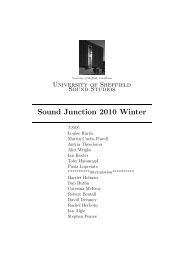Compositional Methods in Electroacoustic Music - Adrian Moore ...
Compositional Methods in Electroacoustic Music - Adrian Moore ...
Compositional Methods in Electroacoustic Music - Adrian Moore ...
You also want an ePaper? Increase the reach of your titles
YUMPU automatically turns print PDFs into web optimized ePapers that Google loves.
3.4 Paper Session 4<br />
Paper 13 - Illustration and the compositional process: an update on pedagogical and creative<br />
uses<br />
15:00<br />
Blackburn, Manuella<br />
Liverpool Hope University<br />
My compositional tool (first presented <strong>in</strong> 2008) based on the vocabulary of Denis Smalley’s Spectromorphology<br />
has more recently evolved <strong>in</strong>to a visually orientated aid for creat<strong>in</strong>g new acousmatic works. This shift<br />
from descriptive language to image has revealed itself to be of great relevance not only to my own creative<br />
practice of acousmatic music composition and mixed <strong>in</strong>strumental/electronics works, but also for pedagogical<br />
situations <strong>in</strong> undergraduate teach<strong>in</strong>g and school-aged learners (between 11-14).<br />
My paper will provide an update of this compositional tool and how illustrations now f<strong>in</strong>d themselves as central<br />
components with<strong>in</strong> the composition construction process. Examples from two recent pieces, Switched On<br />
(2011) and Triple Retort (2011) for cello, flute, mezzo-soprano and three laptops will provide an <strong>in</strong>sight <strong>in</strong>to<br />
the <strong>in</strong>ternal work<strong>in</strong>g of my compositional process, while its application with<strong>in</strong> pedagogy will be discussed us<strong>in</strong>g<br />
examples from teach<strong>in</strong>g experiences trial<strong>in</strong>g the tool <strong>in</strong> the classroom. Offer<strong>in</strong>g the compositional tool<br />
to a new demographic of school-aged learners has demonstrated the great flexibility of this research and the<br />
importance of a visually tangible component when <strong>in</strong>troduc<strong>in</strong>g electroacoustic music (especially acousmatic<br />
music) to those un<strong>in</strong>itiated with the practice.<br />
My illustrations contributed to Leigh Landy’s new book, Mak<strong>in</strong>g <strong>Music</strong> with Sound (NY Routledge) will also<br />
be <strong>in</strong>troduced as a further educational aid and how future developments of this project may take this tool<br />
further a field.<br />
Paper 14 - Notes, Sounds, Outsides and Insides<br />
15:30<br />
Young, John<br />
De Montfort University<br />
This paper exam<strong>in</strong>es the functional uses of pitch <strong>in</strong> acousmatic music. The psychological phenomenon of<br />
pitch is a basic form-bear<strong>in</strong>g element <strong>in</strong> music: scales represent collections of perceptually related discrete<br />
values, while patterns formed from scalic elements can be easily remembered, are <strong>in</strong>variant under transformation,<br />
and can project functional relationships, such as <strong>in</strong> tonal music (McAdams and Saariaho, 1985). In<br />
acousmatic music, pitch has become separated from the self-conta<strong>in</strong>ed doma<strong>in</strong> of the <strong>in</strong>strumental note, viz.<br />
‘note abstraction’ (Francès, 1988) and part of a wider frame of relationships between sounds. Because of its<br />
strong resonance with the <strong>in</strong>strumental tradition, focal pitch can be regarded as a difficult aspect of electroacoustic<br />
music for acousmatic composers. An emphasis on timbral manipulation is often cited as a creative<br />
imperative <strong>in</strong> electroacoustic music: expressed as complex evolv<strong>in</strong>g textures, or as forms developed out of the<br />
sampled sounds of ‘physical’ objects: A traditional model of musical discourse rest<strong>in</strong>g pr<strong>in</strong>cipally on fixed <strong>in</strong>strumental<br />
timbres can suffer <strong>in</strong> acousmatic space by appear<strong>in</strong>g as a k<strong>in</strong>d of second hand reflection of a performance<br />
or, more colloquially, a record<strong>in</strong>g of one.<br />
<strong>Electroacoustic</strong> studio methods and associated rigorous analysis of sound and listen<strong>in</strong>g have taken a lead<strong>in</strong>g<br />
role <strong>in</strong> refocus<strong>in</strong>g musical th<strong>in</strong>k<strong>in</strong>g away from note abstraction toward a more comprehensive view of the<br />
spectromorphological qualities of all sound <strong>in</strong> which a timbre offers a ‘spectrum of available pitches’: a sonic<br />
<strong>in</strong>terior (Smalley, 1986). The multidimensional space encompassed by timbre becomes a rich resource for musical<br />
design. In addition, Erickson (1975) characterised timbre as hav<strong>in</strong>g two basic musical functions: as carrier<br />
and object. As carrier timbre takes a secondary role to the traditional primary functions of pitch and duration,<br />
provid<strong>in</strong>g ‘subjective constancy’ of <strong>in</strong>strument or voice which is tied to and helps del<strong>in</strong>eate the phrase<br />
structure of music. As object it def<strong>in</strong>es units such as <strong>in</strong>strumental identities, as well as the perceived character<br />
of an <strong>in</strong>strument across its registers. In consider<strong>in</strong>g the formation of strategies for work<strong>in</strong>g with pitch,<br />
electroacoustic methods and the concept of a sonic <strong>in</strong>terior raise for the composer the perspective of a cont<strong>in</strong>-<br />
15



